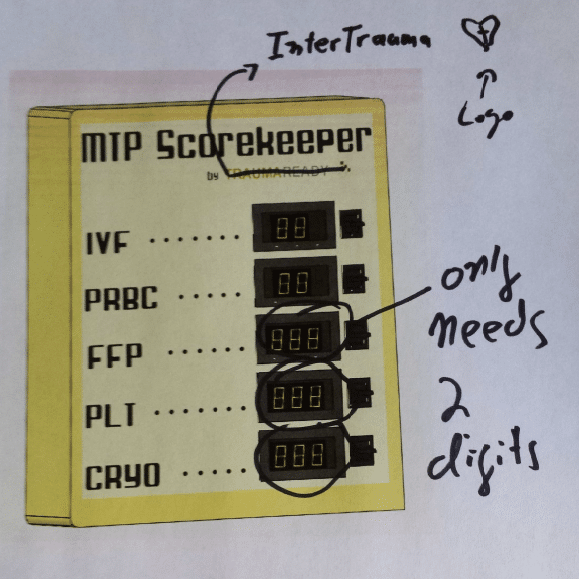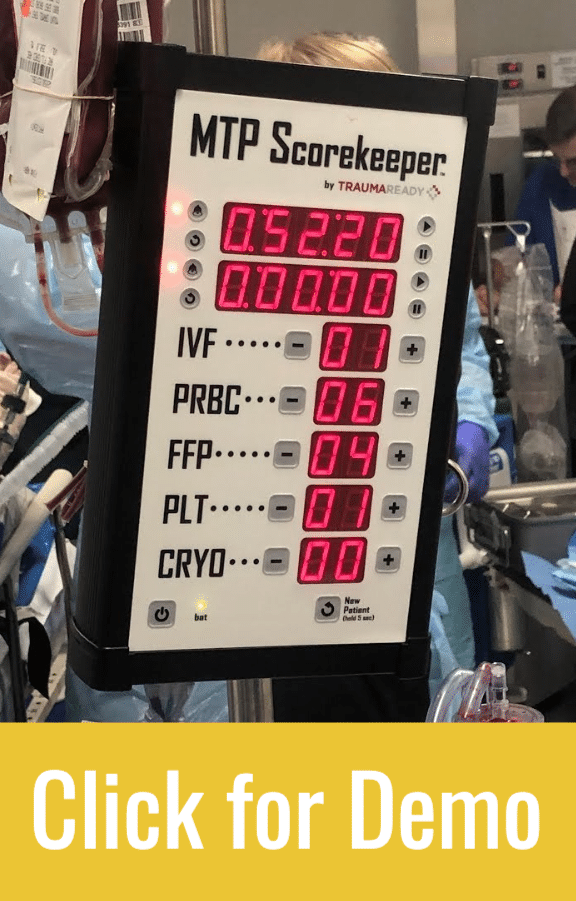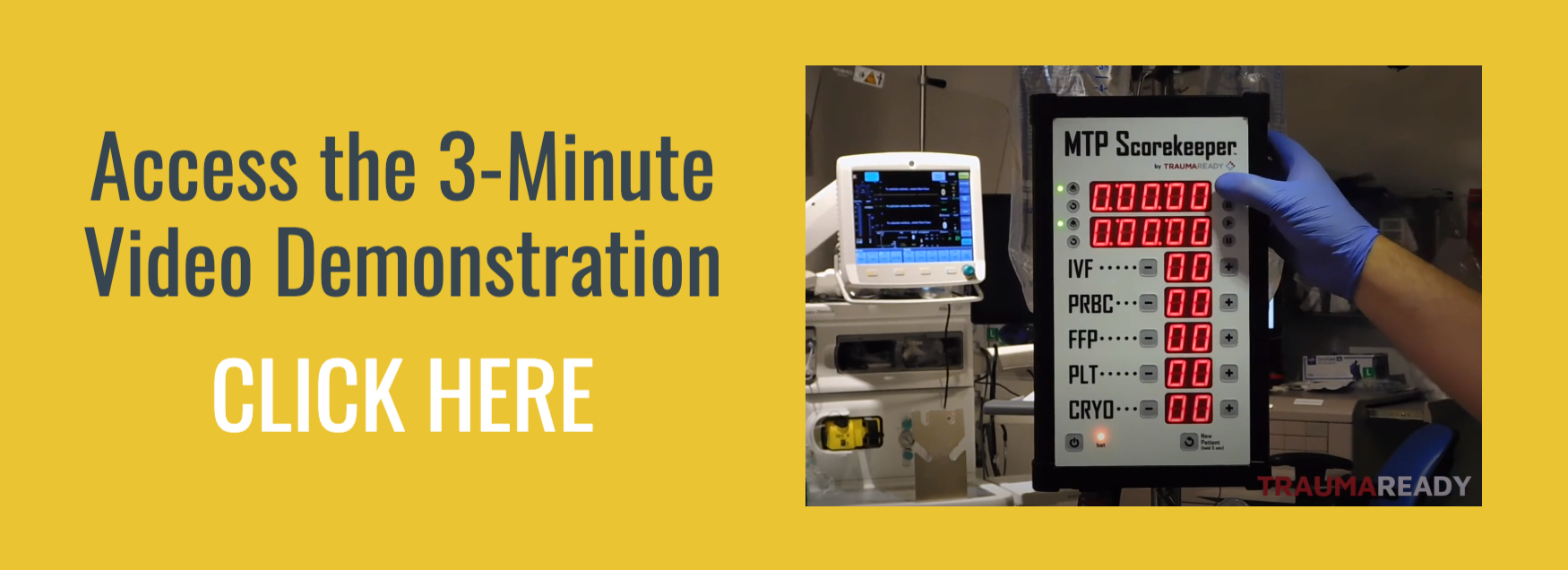Trauma providers are natural problem solvers. They rarely settle for “good enough” but try to find a way to overcome obstacles and get better results. This mindset is one reason I decided to become a trauma surgeon in the first place. And it’s an ideal I had in mind in 2013 when I set out on my own problem-solving journey.
It all started more than a decade ago when the trauma community began to appreciate the value of transfusing blood components in a balanced ratio. Like many others, I began working out the logistics of delivering a balanced massive transfusion protocol (MTP). But as the emerging science around MTP became clearer, it felt like practice in the trauma bay was stuck.
As anyone in trauma knows, delivering a balanced MTP during a chaotic resuscitation is a big challenge. Packed red blood cells, fresh frozen plasma and platelets all arrive in the trauma bay at different times. How many units of each did the patient receive? The trauma team leader often receives several conflicting accounts. On top of that, the biggest MTPs always seem to take place at night or on the weekend when regular staff are off duty.
No matter how hard I tried, I could not figure out a reliable way to make sure component ratios were given accurately. And I was not alone. I worked with trauma teams in several different hospitals, and everywhere I went I saw the same obstacles to delivering a consistent and balanced MTP.
Eventually, I realized the solution to this challenge went beyond standard PI methodologies. Little did I know that I was about to learn many new lessons about problem solving in trauma.
Starting out simple
I believe the best solution to any problem is the simplest solution. So when I started working on my MTP challenge, I wanted the fix to be as straightforward as possible.
My first solution was definitely easy. I created a simple laminated page with check boxes for the different blood components. Whenever a patient received a unit, a nurse would simply check a box with a dry erase marker. Problem solved!
In reality, my form did not work very well. We found that nurses were unable to attend to their duties and use the form consistently. In the heat of the moment, they were often unable to locate a dry erase marker. Frankly, the form became another forgotten piece of paper in the trauma bay.
So I tweaked the idea: same information, but on a 3×5 card. The “owner” of the card would be the trauma team leader, who could mark units as he or she directed the resuscitation.
The index card actually worked pretty well — until it was time to scrub in for surgery. At that point the trauma team leader had to set the card aside and it was again forgotten.
For attempt number three, I put the same information on a large laminated poster. My thought was that “going big” would make it harder for staff to lose sight of the tracker and easier for everyone to focus on the same information.
The problem was that the poster did not travel well. As patients moved from the trauma bay to the OR to the ICU, the poster was usually left behind somewhere along the way.
For my fourth attempt, I realized I needed a new paradigm. I started to experiment with Google Glass, which was new at that time. I was intrigued by the possibility of voice-activated, hands-free tracking and the option to display the team leader’s Glass view on a full-size monitor.
But while Google Glass seemed promising, it was crippled by one practical reality — it was simply too loud in the trauma bay for voice commands to work well.
Then I had a fresh idea: What about creating some kind of lighted “scoreboard” that attaches to the same pole as the rapid infuser? Staff could use the scoreboard to easily keep track of units, and the board would be visible to the entire trauma team no matter where the patient was taken.
Simple solution, right? Again, little did I know…
Iterating on an idea
The scoreboard concept seemed to fulfill all our needs in terms of simplicity, visibility and portability. All I needed to do was find the straightest line to a viable solution.
My first stop was eBay. Surely someone on earth was selling an unneeded scoreboard, right? But I soon realized there was no off-the-shelf solution. Even the smallest scoreboard was way too big. And existing devices only let you keep track of two scores (home and visitor) whereas I needed to keep track of four different blood components.

I briefly considered hiring a toy designer to make what I wanted. Pro: Rapid production of a functioning device. Con: Very unlikely the result would meet hospital safety standards.
I realized the only option was to engage an industrial design firm. Before long I was working with a talented group of designers who were able to take my scoreboard concept from idea to reality. The result was a functioning prototype that I could begin using in the trauma bay.
I spent several years working with the prototype and getting feedback from colleagues. I also spent time talking to experts in the medical device industry. Ultimately, these industry contacts introduced me to a team of medical engineers at Rowan University School of Engineering.
Working with the Rowan team was a game-changer. They helped me address several known problems that had become apparent. For example, they created a custom membrane overlay and redesigned the circuitry to make the scoreboard water-resistant. They also worked out a way to extend the battery life to 6 hours, a major functional improvement.

The engineering team also tackled “user interface” problems that were not even on my radar. For instance, they redesigned the controls so that each button and its associated readout were adjacent. They also made sure the buttons made a satisfying “click” when pressed. These things may not sound like much, but they are critical to making medical devices intuitive for clinical users and obviate the need for in-servicing.
The Rowan team also helped me add an extra feature that supports an effective MTP process — built-in timers that chime every 10 minutes. These optional chimes help trauma teams keep track of the time elapsed since initiation of the MTP, which helps everyone maintain situational awareness during a fast-paced resuscitation.
Finally, after years of development, my solution was ready to be shared with other trauma teams. It is called the MTP Scorekeeper, and it gives trauma providers an easy way to keep track of blood components. It lets all providers see MTP ratios at a glance, whether they are in the trauma bay, the OR, the ICU or the inpatient floor.
7 lessons for problem solving in trauma
The process of developing the MTP Scorekeeper was long but definitely worth it. And I learned several lessons about problem solving that other trauma providers may appreciate.
1. Start with a real need. The more serious the problem, the more motivated you will be to solve it. In my case, the pressing need to maintain balanced MTP ratios kept me focused and on track.
2. Avoid complication as long as possible. My journey led to the development of a new device, but that should never be the starting point. If you can solve a problem with an index card and a marker, do it.
3. Test-drive your ideas. Yes, your idea is brilliant, but you can never be sure it works until you try it out. We tested every aspect of the MTP Scorekeeper over several years. Even the chime sounds were vetted with real surgeons to make sure they got attention without startling someone during a critical operation.
4. Get help from people unlike you. To truly solve a complex problem, you need input from many different perspectives. My experience as a surgeon was key to identifying this problem, but the guidance I received from nurses, technicians, industry experts and engineers was critical to taking my solution from concept to reality. The saying “you don’t know what you don’t know” couldn’t be truer.
5. Realize that every solution leads to a new problem. For example, we recognized that the MTP Scorekeeper needed a stronger battery to extend mobility. So the engineers redesigned the unit with a lithium ion battery. But that made the unit a lot heavier. So the team had to design a new clamp for attaching the device to the infuser pole. I could go on and on, but the lesson is simple: Even when you have the right solution, you still need the patience to work out the bugs.
6. Make your solution versatile. There is no one approach to MTP. While 1:1 is the most common ratio, some trauma centers have adopted 1.5:1 and future research may suggest different targets. That’s why we purposely made the MTP Scorekeeper “ratio agnostic.” The device keeps track of units delivered. It’s up to you to decide what is right for the patient.
7. Make your solution “bonehead simple.” The more intuitive the solution, the more likely it will be adopted. One thing that makes me proud about the MTP Scorekeeper is its simplicity. When I show the device to trauma surgeons and TPMs, they instantly understand the basic idea. The same thing happens when trauma leaders introduce it to their teams: No in-service needed. Nurses get the MTP Scorekeeper with very little explanation. (The interface is really straightforward — to see for yourself, access a short video demonstration.)
Personally, I can add an eighth lesson: I had no idea how expensive it is to design and manufacture a medical-grade product. This experience helped me realize that the only reason some devices cost so little is that the vendor intends to make a large profit on the related consumables.
In contrast, the MTP Scorekeeper is self-contained. The upfront cost is higher than what many trauma professionals are used to, but there are no ongoing costs and the device is nearly maintenance-free. In fact, the initial investment is small compared to the significant costs associated with the alternative — which is doing nothing about your MTP problem.
Understand the cost of not solving your problem
Problem solving in trauma can be as quick as calling a meeting to clarify an issue — or as lengthy as the process I just described. However, at some point there is always the question of whether the cost is worth it.
Here is my suggestion: We definitely need to consider the cost of solving a given problem, but we also need to understand the cost of not solving it.
With regard to the MTP Scorekeeper, the main cost of doing nothing was huge — avoidable mortality resulting from failure to run effective MTPs. Beyond that, there are also operational costs tied to MTP process failures, including endless “root cause analysis” meetings and “close the loop” discussions about how to manage ratios. Ultimately, the cost of inaction includes the possibility of losing trauma center verification because a team cannot consistently deliver correct ratios during a resuscitation.
For most of the problems we encounter in trauma, the cost of inaction far outweighs the cost of finding the right solution.
Alex Guerrero, MD, FACS is a trauma surgeon based in New York City.


